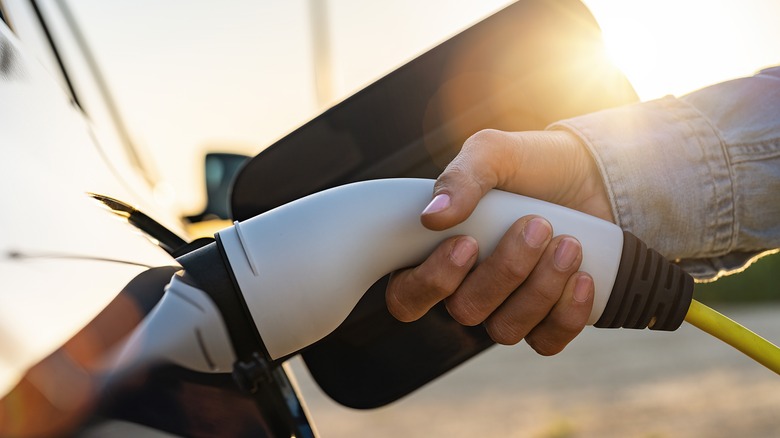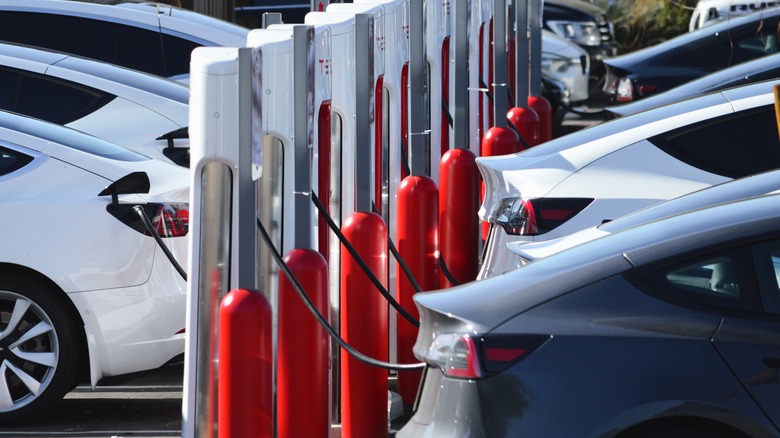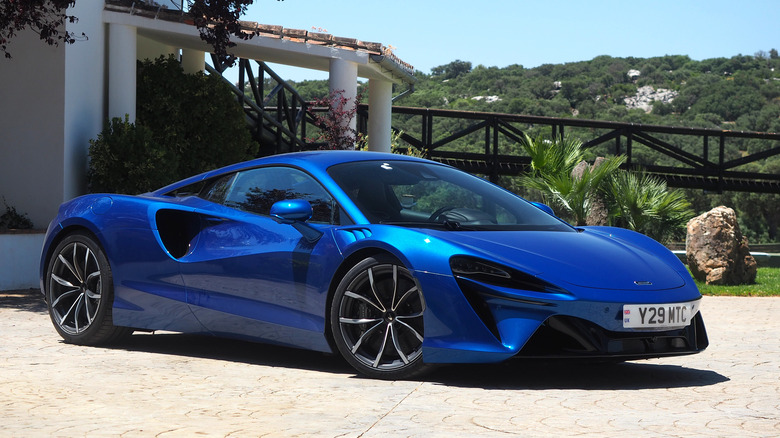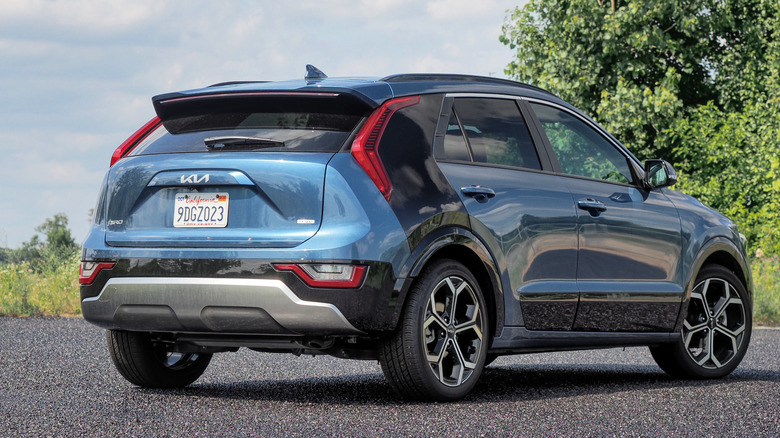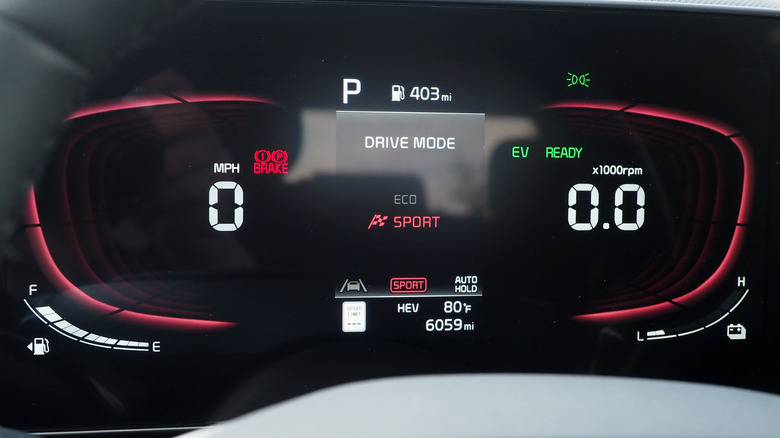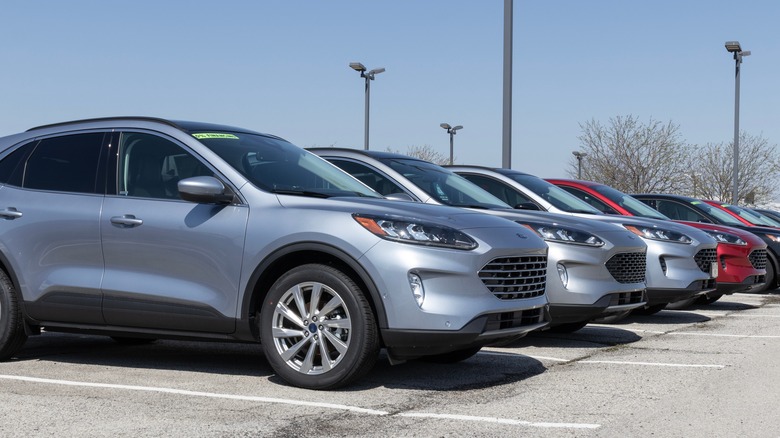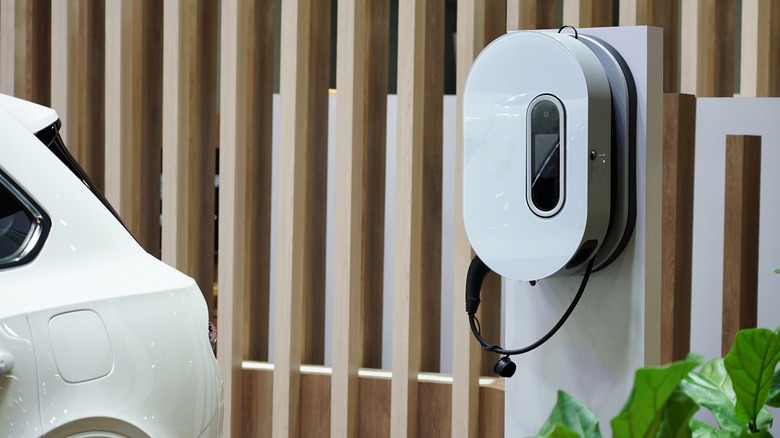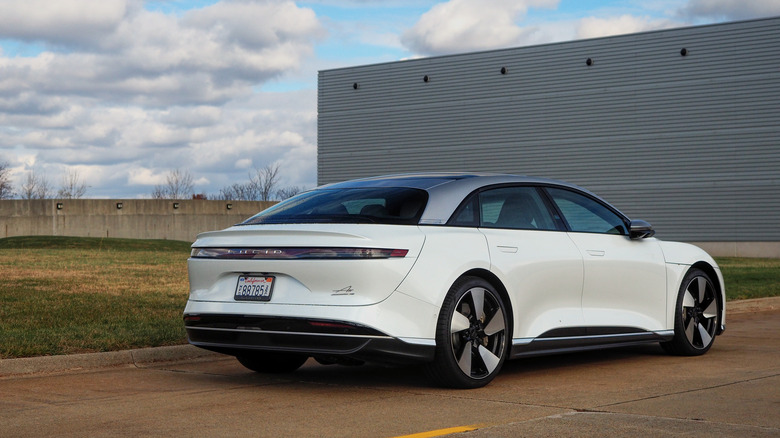5 Reasons To Buy A Plug-In Hybrid (And 5 Reasons Why You Shouldn't)
Electric cars may be the future of transportation, but that doesn't mean going battery-electric is right for every driver today. While there's an understandable appeal in never having to stop at a gas station again, not everyone is quite ready to switch. That can make plug-in hybrids — or PHEVs — very appealing.
Effectively, a plug-in hybrid combines both an internal combustion engine with a battery and at least one electric motor. Unlike a mild hybrid, they support being recharged from an external source. However, unlike a full EV, if the battery runs down then the gas engine can kick in and keep you moving.
Exactly how those two power sources combine varies according to individual manufacturers and vehicles. In some PHEVs, for example, the front wheels are powered by the gas engine while the rear wheels are powered by the electric motor. In other cars, the gas engine acts mainly as a mobile generator, with the electric motors responsible for keeping the PHEV moving.
Either way, a PHEV can make a lot of sense for drivers wanting some of the advantages of electrification, though that's not to say they're the perfect choice for everyone.
Pro: You're not entirely reliant on EV chargers
Probably the biggest single factor making plug-in hybrids appealing is not having to worry so much about range anxiety. Or, specifically, about charging up your vehicle by plugging it in. Although the average American driver uses their car for less than 40 miles each day, there's certainly a perception among many that they need hundreds of miles of potential range before a full EV becomes practical.
For many people, in fact, the typical plug-in hybrid's electric-only range will be sufficient to cover most, if not all, of their daily journeys. Many PHEVs offer control over just when the battery power is used, too: reserving charge for zero-emissions urban zones, for example.
When a plug-in hybrid's battery runs down, however, you still have the convenience and familiarity of the gas engine. Whether it directly drives the wheels or acts as a mobile generator, it's fueled up the same way most people are used to: by pulling up to a gas pump.
Pro: A broader range of body styles
The number of all-electric vehicles is growing considerably, but if you're not in the market for an SUV or a sedan, you might be disappointed. A handful of electric pickup trucks have landed at dealerships too, but nonetheless the range of body styles is fairly small.
If you have your heart set on an all-electric minivan, for example, you're out of luck. Chrysler, though, will happily sell you its Pacifica PHEV, which is rated for up to 32 miles of electric-only driving. Want a true off-roader with all the heritage (and capability) the Jeep badge guarantees? The Wrangler 4xe delivers.
Then there are more lavish options. With the new Tesla Roadster still MIA, perhaps a Ferrari 296 GTB plug-in hybrid will sate your need for speed, or failing that a McLaren Artura. Eventually, we're likely to see more battery-electric vehicles (BEV) filling in the gaps, but with SUVs commanding the lion's share of sales these days, it could take some time for more niche segments to ditch internal combustion entirely.
Pro: Plug-in hybrids can be cheaper than full EVs
Admittedly, a plug-in hybrid Ferrari or McLaren is never going to be considered affordable. Look away from the six-figure supercar segment, however, and you'll often find PHEVs undercutting their all-electric counterparts.
Take, for example, the new Kia Niro. If you want the fully-electric version, complete with 253 miles of EPA range, you're looking at $39,550. The Kia Niro Plug-in Hybrid, in contrast, starts at $33,840. Admittedly, you only get around 33 miles of electric-only range, but after that point, the gas engine kicks in for a total of 510 miles of combined driving.
Kia is a relative rarity, in offering both PHEV and fully-electric versions of the same car. Still, the economies of scale of making internal combustion engines, combined with the still-high cost of large battery packs, typically mean that plug-in hybrids are more affordable than their EV counterparts in the same category.
Pro: Plug-in hybrids can be more fun to drive than gas cars
It doesn't take long behind the wheel of an EV to realize why driving them can spoil you for (most) gas vehicles. After all, that instantaneous torque delivery can make even a cheap electric vehicle feel like it has the eagerness of a sports car. While PHEVs typically don't have the same potency in their electric motors, that doesn't mean you can't feel the difference from a gas-only model.
The key is when electric motors make their contribution. Usually, that's as soon as you hit the accelerator, the electric side of the hybrid drivetrain weighing in straight away, and helping cover for the gas engine as it gets up to speed. As a result, PHEVs can feel perky and surprisingly spritely, despite often being big SUVs.
Lift off the accelerator pedal, meanwhile, and most plug-in hybrids offer selectable regenerative braking: effectively turning the electric motor into a generator, that tops up the battery while the PHEV slows. Where one-pedal modes that can bring a vehicle to a full stop are fairly common in fully electric vehicles, though, that doesn't usually carry over to PHEVs. Still, being able to modulate speed without always switching to the brake is a boon around town.
Pro: Smaller batteries make better use of natural resources
Since a plug-in hybrid isn't reliant solely on electric power to keep you moving, automakers can compromise on the size of the battery they use. Take, for example, the Ford Mustang Mach-E and the Ford Escape PHEV. The all-electric Mustang has between 72 kWh and 91 kWh of usable capacity, specific trim depending (the actual battery capacity is a little higher, but automakers reserve some from day-to-day use so as to leave headroom over time as battery cells degrade).
The Escape plug-in hybrid, in contrast, has a far smaller 14 kWh battery. That means the electric range is much shorter, unsurprisingly — 37 miles, versus a Mustang Mach-E's 312 miles in 91 kWh California Route 1 form — but it also means Ford could build more than six Escape PHEV batteries from the same raw materials that one for the full EV demands.
The contrast gets even more notable with some of the extreme EVs on the market today. The Hummer EV's 212 kWh (usable) battery has enough raw materials to make 15 Ford Escape PHEV batteries.
Con: You still need somewhere to plug in
A plug-in hybrid may bring the reassurance of a gas engine when the battery gets low, but for maximum efficiency at some point, you're probably still going to want to charge up your car again. That means finding somewhere to park and plug in.
For most people, that'll be at home. The same domestic Level 1 and Level 2 chargers that work with fully electric cars will work with a PHEV too. Depending on whether you're using a 120V or 240V outlet, you could be looking at as little as 3-4 hours for a full charge, to 12+ hours.
The majority of PHEVs only support up to Level 2 charging, and don't support plugging in a DC fast charger such as those operated by Electrify America or Chargepoint: they have too many pins to connect properly. That's not to say you won't find a public Level 2 charger, but don't expect the sort of rapid top-up that those with entirely electric vehicles are increasingly enjoying.
Con: A pure EV will have much more electric range
With smaller batteries onboard, you'll be unsurprised to hear that no plug-in hybrid can beat the range of an all-electric vehicle. That means, if you're ready to take the plunge and go zero tailpipe emissions, a full EV is still the best route.
That needn't break the bank along the way. Chevrolet may be retiring this generation of Bolt EV to replace it with a new, updated version, but sales of the popular little electric hatchback will continue until around the end of the year. Just $26,500 gets you what's still a decent range number, despite the Bolt's aging: 259 miles of driving on a full charge.
At the other extreme, there's plenty of EV range if you're willing to open your wallet wide. A Lucid Air Grand Touring, for example, is rated for up to 516 miles... just expect to pay north of $150,000 for the privilege.
Con: There's more to go wrong
Fully electric drivetrains sometimes encounter problems. Gas engines certainly aren't immune to issues. Throw the two together in the same vehicle, then, and you're arguably getting double the potential for glitches.
It turns out, some of that paranoia might be well-founded. Consumer Reports, in its 2022 Brand Reliability Rankings, found that plug-in hybrids tended to be less reliable than their regular hybrid counterparts. That said, the study also found that full EVs could often encounter charging and battery problems, along with electric drive motor issues.
Automakers have responded to those concerns by loading their plug-in hybrids up with lengthy powertrain warranties. Kia's 2023 Niro PHEV, for example, may start at under $34k, but it still gets a 10-year/100,000-mile limited powertrain warranty. Toyota's Prius Prime is even more affordable, but it comes with a 5-year/60,000 miles limited powertrain warranty.
Con: You may not qualify for as many incentives
One of the big motivating factors for drivers to switch to electric vehicles has been the promise of tax incentives and credits from the federal government. Just as with fully electric vehicles, plug-in hybrids are subject to the amended U.S. tax incentives that are part of the Inflation Reduction Act of 2022. That now requires electrified vehicles to go through final assembly in North America and to meet critical minerals and battery component requirements, along with battery capacity minimums, in order to qualify for the full tax incentive of $7,500.
As it stands, that means just eight plug-in hybrid vehicles are currently eligible for any amount of U.S. federal tax incentive, out of the roughly 30 on the market currently. That includes models like the BMW x5 xDrive50e, the Lincoln Corsair Grand Touring, and the Ford Escape Plug-in Hybrid. Even then, though, it's worth paying attention to the small print.
For example, if you get carried away with the options, you might break past the $80,000 MRSP limit and be ineligible for the incentive. Only two of the eight eligible PHEVs qualify for the full $7,500, too: the Chrysler Pacifica PHEV and the Lincoln Aviator Grand Touring. The rest are capped at $3,750.
Con: Your choices are limited
Perhaps as a consequence of the complexity, and uncertainty among EV newbies as to just what makes a plug-in hybrid, automakers have been fairly cautious when it comes to launching new models. Chevrolet discontinued its Volt PHEV back in 2019, while Honda discontinued its Clarity Plug-in Hybrid in 2021. Neither launched a new PHEV to replace those cars, looking to fully electric models instead.
It means there are only around 30 different PHEVs on sale in the U.S. today, spanning automakers from BMW to Volvo. While plug-in hybrids may stray outside of the usual "it's an SUV or a sedan" categories we've seen most fully-electric cars stick to, that broader array of segments means there might only be a small handful of options if you're looking for, say, a PHEV wagon.
While we're still seeing a trickle of new plug-in hybrid models launch each year, the electrified attention of the industry as a whole is decidedly focused on EVs with batteries alone. Nonetheless, for those looking to take a step into electrification without giving up on gasoline's reassurance completely, it might be worth adding a PHEV to the list of possibilities.
